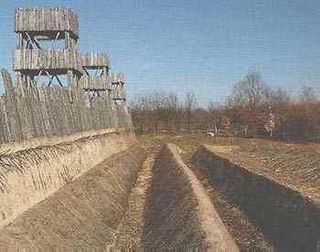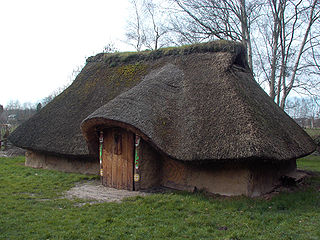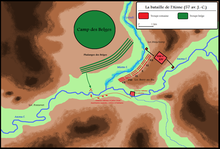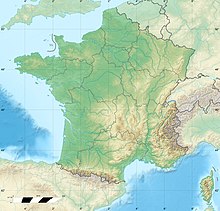
Ambiorix was, together with Cativolcus, prince of the Eburones, leader of a Belgic tribe of north-eastern Gaul, where modern Belgium is located. In the nineteenth century Ambiorix became a Belgian national hero because of his resistance against Julius Caesar, as written in Caesar's Commentarii de Bello Gallico.

Vercingetorix was a Gallic king and chieftain of the Arverni tribe who united the Gauls in a failed revolt against Roman forces during the last phase of Julius Caesar's Gallic Wars. Despite having willingly surrendered to Caesar, he was executed in Rome.

This article concerns the period 59 BC – 50 BC.
Year 57 BC was a year of the pre-Julian Roman calendar. Contemporaneously, in the Roman Republic, it was known as the Year of the Consulship of Lentulus and Metellus. The denomination 57 BC for this year has been used since the early medieval period, when the Anno Domini calendar era became the prevalent method in Europe for naming years.

The Gallic Wars were waged between 58 and 50 BC by the Roman general Julius Caesar against the peoples of Gaul. Gallic, Germanic, and British tribes fought to defend their homelands against an aggressive Roman campaign. The Wars culminated in the decisive Battle of Alesia in 52 BC, in which a complete Roman victory resulted in the expansion of the Roman Republic over the whole of Gaul. Though the Gallic military was as strong as the Romans, the Gallic tribes' internal divisions eased victory for Caesar. Gallic chieftain Vercingetorix's attempt to unite the Gauls under a single banner came too late. Caesar portrayed the invasion as being a preemptive and defensive action, but historians agree that he fought the Wars primarily to boost his political career and to pay off his debts. Still, Gaul was of significant military importance to the Romans. Native tribes in the region, both Gallic and Germanic, had attacked Rome several times. Conquering Gaul allowed Rome to secure the natural border of the river Rhine.

The Nervii were one of the most powerful Belgic tribes of northern Gaul at the time of its conquest by Rome. Their territory corresponds to the central part of modern Belgium, including Brussels, and stretched southwards into French Hainault. During their first century BC Roman military campaign, Julius Caesar's contacts among the Remi stated that the Nervii were the most warlike of the Belgae. In times of war, they were known to trek long distances to take part in battles. Being one of the distant northern Belgic tribes, with the Menapii to the west, and the Eburones to their east, they were considered by Caesar to be relatively uncorrupted by civilization.

The Battle of Alesia or Siege of Alesia was a military engagement in the Gallic Wars around the Gallic oppidum of Alesia in modern France, a major centre of the Mandubii tribe. It was fought by the Roman army of Julius Caesar against a confederation of Gallic tribes united under the leadership of Vercingetorix of the Arverni. It was the last major engagement between Gauls and Romans, and is considered one of Caesar's greatest military achievements and a classic example of siege warfare and investment; the Roman army built dual lines of fortifications – an inner wall to keep the besieged Gauls in, and an outer wall to keep the Gallic relief force out. The Battle of Alesia marked the end of Gallic independence in the modern day territory of France and Belgium.

The Battle of the Sabis, also known as the Battle of the Sambre or the Battle against the Nervians, was fought in 57 BC near modern Saulzoir in Northern France, between Caesar's legions and an association of Belgae tribes, principally the Nervii. Julius Caesar, commanding the Roman forces, was surprised and nearly defeated. According to Caesar's report, a combination of determined defence, skilled generalship, and the timely arrival of reinforcements allowed the Romans to turn a strategic defeat into a tactical victory. Few primary sources describe the battle in detail, with most information coming from Caesar's own report on the battle from his book, Commentarii de Bello Gallico. Little is therefore known about the Nervii perspective on the battle.

The Belgae were a large confederation of tribes living in northern Gaul, between the English Channel, the west bank of the Rhine, and the northern bank of the river Seine, from at least the third century BC. They were discussed in depth by Julius Caesar in his account of his wars in Gaul. Some peoples in Britain were also called Belgae, and O'Rahilly equated them with the Fir Bolg in Ireland. The Belgae gave their name to the Roman province of Gallia Belgica and, much later, to the modern country of Belgium; today "Belgae" is also Latin for "Belgians".

Gallia Belgica was a province of the Roman Empire located in the north-eastern part of Roman Gaul, in what is today primarily northern France, Belgium, and Luxembourg, along with parts of the Netherlands and Germany.

The Menapii were a Belgic tribe dwelling near the North Sea, around present-day Cassel, during the Iron Age and the Roman period.
Ariovistus was a leader of the Suebi and other allied Germanic peoples in the second quarter of the 1st century BC. He and his followers took part in a war in Gaul, assisting the Arverni and Sequani in defeating their rivals, the Aedui. They then settled in large numbers into conquered Gallic territory, in the Alsace region. They were defeated, however, in the Battle of Vosges and driven back over the Rhine in 58 BC by Julius Caesar.

The Remi were a Belgic tribe dwelling in the Aisne, Vesle and Suippe river valleys during the Iron Age and the Roman period. Their territory roughly corresponded the modern Marne and Ardennes and parts of the Aisne and Meuse departments.

The Bellovaci were a Belgic tribe dwelling in the modern Picardy region, near the present-day city of Beauvais, during the Iron Age and the Roman period. After they were defeated by Caesar in 57 BC, they gave lukewarm support to the Gallic revolt led by Vercingetorix in 52 BC. The Bellovaci nonetheless organized resistance against Rome in 51 BC.

The Suessiones were a Belgic tribe, dwelling in the modern Aisne and Oise regions during the La Tène and Roman periods.
Gaius Volusenus Quadratus was a distinguished military officer of the Roman Republic. He served under Julius Caesar for ten years, during the Gallic Wars and the civil war of the 40s. Caesar praised him for his strategic sense and courageous integrity.

Durocortorum was the name of the city Reims during the Roman era. It was the capital of the Remi tribe and the second largest city in Roman Gaul.

In the course of his Gallic Wars, Julius Caesar invaded Britain twice: in 55 and 54 BC. On the first occasion Caesar took with him only two legions, and achieved little beyond a landing on the coast of Kent. The second invasion consisted of 628 ships, five legions and 2,000 cavalry. The force was so imposing that the Britons did not dare contest Caesar's landing in Kent, waiting instead until he began to move inland. Caesar eventually penetrated into Middlesex and crossed the Thames, forcing the British warlord Cassivellaunus to surrender as a tributary to Rome and setting up Mandubracius of the Trinovantes as client king.

The Viromanduī or Veromanduī were a Belgic tribe dwelling in the modern Vermandois region (Picardy) during the Iron Age and Roman periods. During the Gallic Wars, they belonged to the Belgic coalition of 57 BC against Caesar.

The Battle of Lutetia was a battle on the plain of Grenelle in what is now Paris between Roman forces under Titus Labienus and an anti-Roman Gallic coalition in 52 BC during the Gallic Wars. It was a Roman victory.


















